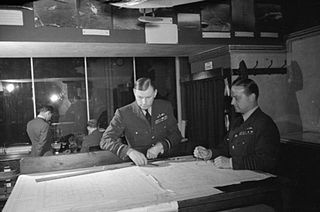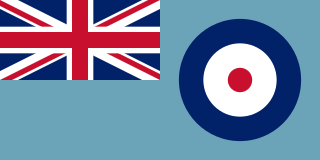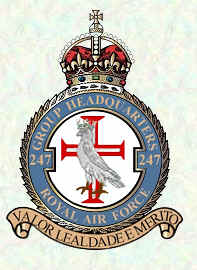Related Research Articles
The Commandant of the Royal College of Defence Studies, formerly the Commandant of the Imperial Defence College, is the head of the Royal College of Defence Studies, a British military staff college which instructs senior officers, diplomats, and civil servants.

Sir Geoffrey Rhodes Bromet was a senior Royal Air Force (RAF) officer during the Second World War and Lieutenant Governor of the Isle of Man from 1945 to 1952. Bromet Road in the town of Castletown, Isle of Man, takes its name from him.

Air Vice-Marshal William Hopton Anderson, was a senior commander in the Royal Australian Air Force (RAAF). He flew with the Australian Flying Corps in World War I, earning the Distinguished Flying Cross and the Belgian Croix de guerre for his combat service with No. 3 Squadron on the Western Front in 1917. The following year he took command of No. 7 (Training) Squadron and, later, No. 3 Squadron. Anderson led the Australian Air Corps during its brief existence in 1920–21, before joining the fledgling RAAF. The service's third most-senior officer, he primarily held posts on the Australian Air Board in the inter-war years. He was appointed a Commander of the Order of the British Empire in 1934, and promoted to air commodore in 1938.

No. 616 Squadron is an active Reserve unit of the Royal Auxiliary Air Force (RAuxAF) assigned to the RAF ISTAR Force at RAF Waddington. It was originally formed as a unit of the British Auxiliary Air Force in 1938, active throughout World War 2 as a fighter unit, becoming the 1st operational RAF unit to fly jets and disbanded in 1957. The unit reformed in its current guise in April 2019 as 616 Squadron Royal Auxiliary Air Force.
Air Commodore Jeaffreson Herbert Greswell, was a British pilot during the Second World War and a senior Royal Air Force officer in the post-war years. As an air commodore, Greswell served as the eleventh Commandant Royal Observer Corps between June 1964 and June 1968.

Harry George Smart, is best known for having been the commander of RAF Habbaniya during the first part of the Anglo-Iraqi War. Smart was an officer in the British Army, the Royal Flying Corps and the Royal Air Force. He served during the First World War, during the interwar period, and during the Second World War.

Air Headquarters Malta was an overseas command of the Royal Air Force (RAF) during the Second World War. It was established on 28 December 1941 by renaming RAF Mediterranean under Air Vice Marshal Hugh Lloyd. Lloyd was named Air Officer Commanding in Malta on 1 June 1941.
Air Marshal Sir Paul Davie Holder, was a Royal Air Force officer who became Air Officer Commanding-in-Chief at RAF Coastal Command.

Air Vice Marshal Wilfred Ashton McClaughry,, born Wilfred Ashton McCloughry, was an Australian aviator and air commander who served in the Australian Flying Corps during the First World War and Royal Air Force in the Second World War. His senior commands included: British Forces Aden (1930s), and; No. 9 Group RAF, and Air Officer Commanding Air Officer Commanding Allied Headquarters Egypt. McClaughry was killed, while a passenger, in a flying accident in Cairo in 1943.
Air Vice Marshal Thomas Audley Langford-Sainsbury, was a senior Royal Air Force officer who commanded British Air Forces in Egypt during the Second World War.

No. 15 Group was a group of the Royal Air Force, which disbanded in 1945. It was operational in the last year of, and just after, the First World War, a reformation saw it active throughout the Second World War.

No. 16 Group RAF was a group of the Royal Air Force. It existed over two periods in two different roles. No. 16 Group was initially a training group, from 1918 to 1920, that had been transferred from the Royal Flying Corps. It reformed as a reconnaissance group under RAF Coastal Command, in 1936.
The New Year Honours 1964 were appointments in many of the Commonwealth realms of Queen Elizabeth II to various orders and honours to reward and highlight good works by citizens of those countries. They were announced on 1 January 1964 to celebrate the year passed and mark the beginning of 1964.

No. 17 Group RAF was a group of the Royal Air Force which was operational in the last year of the First World War, and throughout the Second World War.
The 1943 New Year Honours were appointments by King George VI to various orders and honours to reward and highlight good works by citizens of the United Kingdom and British Empire. They were announced on 29 December 1942.

No. 19 Group was a group of the Royal Air Force, active during 1918, and then from 1941–1969.

No. 23 Group RAF was a group of the Royal Air Force, first established in 1918. It disbanded the same year but reformed during 1926 and finally disbanded for the second time in 1975.
Air Vice Marshal Henry Rudolph Graham, was a senior Royal Air Force officer.
Air Vice-Marshal Frederick Desmond Hughes, was a Royal Air Force officer who served as Air Officer Commanding at No. 18 Group.

No. 247 Group was formed in October 1943 within RAF Coastal Command to control units operating from the Azores. It disbanded in March 1946.
References
- Footnotes
- Citations
- 1 2 3 4 Ashworth 1992, Appendix II
- 1 2 3 4 5 6 7 8 9 10 11 Lake 1999, p. 264.
- ↑ Delve 1994, p. 51.
- 1 2 Lake 1999, p. 282.
- 1 2 Lake 1999, pp. 29-30.
- 1 2 Lake 1999, p. 182.
- ↑ Lake 1999, p. 183.
- 1 2 Lake 1999, p. 270.
- 1 2 3 4 5 Lake 1999, pp. 270-271.
- 1 2 3 4 5 Ashworth 1992, Appendix III
- 1 2 3 4 Lake 1999, p. 256.
- ↑ Lake 1999, p. 48.
- 1 2 3 4 5 6 7 Ashworth 1992, Appendix IV
- 1 2 3 4 5 6 7 8 9 10 11 12 13 14 15 Lake 1999, p. 87.
- 1 2 3 4 5 6 7 Lake 1999, p. 259.
- 1 2 3 Lake 1999, p. 260.
- ↑ Lake 1999, pp. 87-88.
- 1 2 Lake 1999, p. 257.
- 1 2 "Consolidated PBY Catalina in US Navy Service".
- 1 2 3 4 5 6 7 8 9 10 11 12 13 14 15 16 Ashworth 1992, Appendix V
- ↑ name="RCAF Squadron Histories and Aircraft, Kostenuk, Griffin"
- 1 2 name=RCAF Squadron Histories and Aircraft, Kostenuk, Griffin
- 1 2 Matusiak 2007, p. 21.
- 1 2 3 Lake 1999, p. 262.
- ↑ Lake 1999, p. 90.
- 1 2 Lake 1999, p. 255.
- 1 2 Lake 1999, pp. 255-256.
- ↑ Lake 1999, p. 146.
- ↑ See also Order of battle 6 June 1944, including Nos 4,5,6,7,9, 131, 132 OTUs and . .
- ↑ Lake 1999, p. 99.
- Bibliography
- Ashworth, Chris. RAF Coastal Command: 1936–1969. Patrick Stephens Ltd. 1992. ISBN 1-85260-345-3
- Blumenson, Martin & Greenfield, Ken. Command Decisions. United States Government Printing. 1984. ISBN 978-0-16-001912-8
- Buckley, John. The RAF and Trade Defence, 1919–1945: Constant Endeavour. Ryburn Publishing. 1995. ISBN 1-85331-069-7
- Buckley, John. Air Power in the Age of Total War. UCL Press. 1998. ISBN 1-85728-589-1.
- Blair, Clay. Hitler's U-Boat War: The Hunters 1939–1942 Cassel & Co. 1996. ISBN 0-304-35260-8
- Blair, Clay. Hitler's U-Boat War: The Hunted 1942–1945. Cassel & Co. 1996. ISBN 0-304-35261-6
- Bowyer, Chaz. Coastal Command at War. Shepperton, Surrey, UK: Ian Allan Ltd., 1979. ISBN 0-7110-0980-5.
- Corum, James. The Luftwaffe: Creating the Operational Air War, 1918–1940. Kansas University Press. 1997. ISBN 978-0-7006-0836-2
- de la Ferté, Philiip Joubert. The Birds and the Fishes: The Story of Coastal Command. Hutchinson. 1960. (No ISBN)
- Delve, Ken. The Source Book of the RAF. Shrewsbury, Shropshire, UK: Airlife Publishing Ltd., 1994. ISBN 1-85310-451-5.
- Forczyk, Robert. Fw 200 Condor Vs Atlantic Convoys, 1941–1943. Osprey Publications. 2010. ISBN 978-1-84603-917-1
- Goulter, Christina. A Forgotten Offensive: Royal Air Force Coastal Command's Anti-Shipping Campaign, 1940–1945. Frank & Cass. London. 2005. ISBN 0-7146-4147-2.
- Hendrie, Andrew. The Cinderella Service: RAF Coastal Command 1939–1945. Pen & Sword Aviation. 2006. ISBN 978-1-84415-346-6.
- Hyde, H. Montgomery. British Air Policy Between the Wars, 1918–1939. Heineman 1977. ISBN 0-434-47983-7.
- Kostenuk S. Griffin J. RCAF Squadron Histories and Aircraft, Samuel Stevens Hakkert & Company, 1977. ISBN 0-88866-577-6
- Lake, Alan. Flying Units of the RAF: The ancestry, formation and disbandment of all flying units from 1912. Shrewsbury, Shropshire, UK: Airlife Publishing, 1999. ISBN 1-84037-086-6.
- March, Daniel J. British Warplanes of World War II. Rochester, Kent, UK: Grange Books, 1998. ISBN 1-84013-391-0.
- Matusiak, Wojtek. Merlin PR Spitfires (Classic Warbirds No. 10). Wellington, New Zealand: Ventura Publications, 2007. ISBN 0-9582296-2-7.
- Nesbit, Roy Conyers. Coastal Command in Action, 1939–1945. Budding Books. 2000 (2nd Edition). ISBN 1-84015-112-9
- Rawlings, John D.R. Coastal, Support and Special Squadrons of the RAF and their Aircraft. London, Jane's Publishing Company Ltd., 1982. ISBN 0-7106-0187-5.
- Saunders, Hilary Aidan St. George and Denis Richards. Royal Air Force, 1939–1945. Volume III: The Fight is Won. Her Majesty's Stationery Office, 1975. ISBN 0-11-771594-8.
- Terraine, John. Business in Great Waters: The U-Boat Wars, 1916–1945. Leo Cooper. London. 1989. ISBN 0-85052-760-0